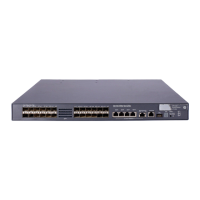77
Configuring the maximum port rate
The maximum rate of a port refers to the maximum number of BPDUs the port can send within each hello
time. The maximum rate of a port is related to the physical status of the port and the network structure.
Make this configuration on the root bridge and on the leaf nodes separately.
To configure the maximum rate of a port or a group of ports:
To do... Use the command... Remarks
1. Enter system view
system-view —
Enter Ethernet interface
view or Layer 2
aggregate interface view
interface interface-type
interface-number
2. Enter
interface
view or port
group view
Enter port group view
port-group manual port-group-
name
Required.
Use either command.
3. Configure the maximum rate of the ports
stp transmit-limit limit
Required.
10 by default.
The higher the maximum port rate is, the more BPDUs will be sent within each hello time, and the more
system resources will be used. By setting an appropriate maximum port rate, you can limit the rate at
which the port sends BPDUs and prevent MSTP from using excessive network resources when the network
becomes instable. HP recommends that you use the default setting.
Configuring ports as edge ports
If a port directly connects to a user terminal rather than another device or a shared LAN segment, this
port is regarded as an edge port. When a network topology change occurs, an edge port will not cause
a temporary loop. Because a device does not know whether a port is directly connected to a terminal,
you need to manually configure the port to be an edge port. After that, this port can transition rapidly
from the blocked state to the forwarding state without delay.
Make this configuration on the root bridge and on the leaf nodes separately.
To specify a port or a group of ports as edge port or ports:
To do... Use the command... Remarks
1. Enter system view
system-view —
Enter Ethernet interface
view or Layer 2 aggregate
interface view
interface interface-type
interface-number
2. Enter
interface
view or port
group view
Enter port group view
port-group manual port-
group-name
Required.
Use either command.
3. Configure the current ports as edge ports
stp edged-port enable
Required.
All ports are non-edge ports
by default.
With BPDU guard disabled, when a port set as an edge port receives a BPDU from another port, it will
become a non-edge port again. To restore the edge port, re-enable it.
If a port directly connects to a user terminal, configure it as an edge port and enable BPDU guard for it.
This enables the port to transition to the forwarding state fast while ensuring network security. Otherwise,

